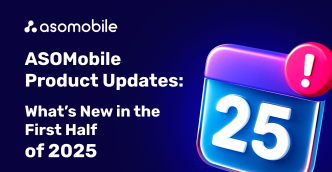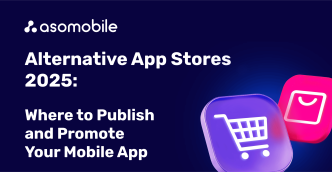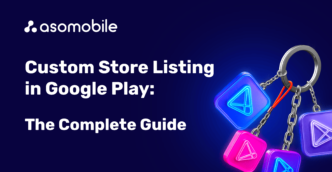KPIs for mobile applications
The importance of KPIs for mobile applications cannot be overestimated. There are many metrics that form performance indicators, and only some of them will be key. Of course, there are universal KPIs that all types of applications should rely on. But the secret to success lies in the precise and specific definition of performance indicators for each individual app. It is these indicators that will show whether the app is working well and will indicate points that need to be improved.
The topic covered is so vast and popular that, perhaps, this article begins with a conclusion that at first glance will seem short, but after reading this article, the view will gain depth and even some enlightenment.
Conclusion: There are many KPIs for mobile applications, even a lot, but in most cases, it is worth focusing your efforts on key performance indicators aimed at attracting, engaging, retaining and monetizing users.
An overview of these and other KPIs for mobile applications is below. Here are clear answers to common questions:
- What are mobile app metrics and how do they differ from performance indicators?
- How to evaluate the effectiveness of a mobile application?
- And of course, what are the main ASO-KPIs?
What are mobile app metrics and how do they differ from performance indicators?
Absolutely any application has a set of certain characteristics, which are usually called metrics. Often, metrics are summary data, such as downloads, session duration, or crash rates. That is, this is, for the most part, statistical information about the operation of the application, which in itself is not very informative. But, if these metrics are analyzed or compared with each other, you will get clear and visual performance indicators. The most relevant and working ones for each specific app are key performance indicators - KPI.
It's worth noting that both metrics and KPIs measure app performance, but they tell the story from different perspectives. Metrics speak to the productivity of the app as a whole, while key performance indicators characterize its success in the market.
How to evaluate the effectiveness of a mobile application?
The effectiveness of a mobile app shows how well the app achieves its goals. For example, how much revenue the app generates, what its popularity among users is, and whether it is a leader in the market. Naturally, the higher the income, popularity or position in the store ranking, the more effective the app. In simple words - more successful.
To evaluate something, you need to understand what criteria it is evaluated by. Therefore, to evaluate the effectiveness of a mobile app, you should decide on its performance indicators and select the most relevant and pressing ones from them - the key criteria. Tautological “efficiencies” hurt the eyes, but there is no getting away from it.
Whatever floats your boat, everyone groups KPIs the way the see that. The main thing to understand is that no matter how you group them, the metrics themselves remain unchanged. So, you can evaluate a mobile application using the following pools of indicators:
- General KPIs
- Application interaction KPIs
- Monetization KPIs
- User Experience KPIs
- Mobile app marketing KPIs
- KPI ASO
Some performance indicators will be described in more detail, while others are indicated for general information. Because there are a lot of indicators and detailed information about each one simply cannot fit into one article. It is important to understand that from all possible KPIs, you should select those that are relevant and vital for a specific application.
General KPIs
- Growth rate of the number of users = (number of current users—number of users in the previous period/number of users in the previous period)X100. It can be any period: week, month, year.
- Mobile downloads. The more the better.
- Retention rate=(number of users at the end of the period—number of new users for the same period/number of users at the beginning of the period)X100
- Installations. Track their number. Remember that downloads do not equal installations. The user can download the application but not complete the installation process. For example, not completing registration completely. Start the process and then forget. Therefore, downloads and installations are two different criteria, each of which should be monitored separately.
- Deletions. It is important here to analyze their cause. It’s one thing if the user doesn’t like the app, but quite another if the deletion is due to incorrect operation or failures in the app itself. Monitor and correct.
- Registration. This usually requires users' contact information. So you can use it to, for example, make mailings.
- Subscriptions. We monitor the number of subscriptions and unsubscriptions. We analyze, draw conclusions, react, change for the better.
- Crashes. Not allowed. We monitor the quantity and eliminate the causes promptly.
- Updates. In the context of paid subscriptions, we note the number of those who agreed to a paid update vs. those who remained on the free (basic) platform. Plus, we compare the ratings of the paid and free versions.
- NPS (Net Promoter Score) - consumer loyalty index. Shows the attitude towards the application through a survey (satisfied-dissatisfied, recommend-don’t recommend, etc). NPS = promoters (loyal users) - critics.

- ASO Basics for Google Play and App Store Apps
- Creating and Analyzing the Semantic Core
- Text Optimization for App Store and Google Play
- Icon, Screenshots, Video
- A/B Testing Featuring, Similar Apps, Ratings, Working with Reviews
App interaction KPIs
- Here it is appropriate to start with sessions. By those, each app understands its own group of specific actions, so it is necessary to specify the meaning of “session” for each individual app. This will help structure further analytics.
Don’t forget about the duration of the session, its interval and depth, as well as the average number of screens per visit. Usually, the higher these indicators, the better, but nuances must be taken into account. If new content is released in the application once a day, then the session interval is appropriate.
- DAU/WAU/MAU (Day/Week/Monthly Active Users) - reflects the number of active users per day/week/month.
There are also Daily Sessions per DAU - the number of daily sessions of one user. The indicator is relevant for social networks and instant messengers. In general, DAU indicates the demand for the application among users.
Daily Sessions per DAU=number of sessions per day/number of unique users per day.
From DAU and MAU comes Stickiness - the frequency of interaction with the application, aka loyalty.
Stickiness=(DAU/MAU)X100%. Ideally, this figure should be (75-90)%.
It is appropriate to say here that by sessions, each app understands its own group of specific actions, so it is necessary to specify the meaning of “session” for each individual application.
- Brand awareness must not only be increased, but also monitored. Where, when, who and in what context the brand was mentioned. It will help you adjust the path of promoting the brand itself.
- Social aspects are the same story as with a brand, only in social networks. Is the app shared on social networks, is it mentioned and, if so, what is the scenery. Relevant for applications related to social networks.
- The level of outflow here, the lower, the better. Outflow may be due to crashes, infrequent updates, or low functionality.
Monetization KPIs
Perhaps the most valuable, since the application must generate revenue.
- Time of first purchase = date of first purchase - date of registration, in days. It doesn’t matter what the user bought, a subscription, in-game goodies or a product (for commercial apps).
- Conversion rate (organic and paid). We analyze conversion sources and trim the sails to the wind.
- LTV (Lifetime Value) - customer lifetime value = average conversion value X average number of conversions for the selected period X average customer lifetime (retention). LTV shows revenue from customers and helps predict future profits. Typically, LTV is calculated for a specific period, such as updates or special offers).
- ARPU (Average Revenue Per User) is the average revenue per user for a selected period of time. ARPU is often mistaken for LTV and vice versa. Therefore, once again, the difference between them is in time, ARPU is always about a specific period, and LTV characterizes the entire time the client uses the application. It must be said that ARPPU (Average Revenue Per Paying User) is also distinguished and this is the average income for the period from paying users, and ARPU is the average income from all paying and non-paying users for the period.
ARPU=revenue for the period/number of all users for the period.
- CAC, CPA and CPI - all three indicators characterize the efforts of advertising campaigns. CAC and CPA are often confusing, but they shouldn't be. CAC (Customer Acquisition Cost) talks about the cost of attracting a user, and CPA (Cost Per Action) talks about the cost of the necessary conversion (for example, a purchase) that the user made. Accordingly, the formulas look like this:
CAC=cost of attracting a new user/number of new customers.
CPA=cost of conversions/number of conversions.
By the way, LTV must be higher than CPA, otherwise more money is spent on attracting a user than he brings in.
CPI (Cost Per Install) is the cost of installation and measures the cost of attracting users from advertising campaigns. Identifies paid rather than organic installs. A type of CPA.
It is important not to be confused with the Consumer Price Index - this indicator shows the dynamics of prices for goods and services from the physical, not mobile world.
- ROI (Return on Investment) - the return on investment of all marketing in general or some specific advertising campaigns. Anything above 100% ROI is profit.
ROI=(return on investment—price of investment/price of investment)X100%
User Experience KPIs
These are important KPIs, because a negative user experience with the app will lead to refusal of the app. And no users - no success, no revenue. Everyone always needs users, especially new ones.
- Loading time and transition from one screen/action to the next should be minimal, as should API latency, and the overall speed of the app should be high.
- Gadgets, software, Internet providers. Form factors, Android or iOS. The application must be productive on all types of devices with any software. Knowing Internet providers is useful in terms of application localization.
- Resolution, screen sizes. Knowing the devices used by users from the previous paragraph, it will be convenient to create suitable updates. The more suitable, the fewer deletions and failures.
Mobile app marketing KPIs
- Sources of installations and referrals. Social component of the application. Where do users find information about the application - organic or advertising, word of mouth, social networks, through which store. Important questions, by answering which you can adjust the course of the application in a more successful direction.
- Factor K. It shows the virality of the application - this is viral popularity, rumors, word of mouth, word of mouth. Factor K = number of mentions (organic or paid companies) x conversion to desired action. It is important to choose one source (organic or advertising) and analyze the entire period based on it.
- Localization (geography). In which regions is the application more in demand, and where has it already become saturated? From here you can predict future income.
- Demography. Gender, age, nationality. Ability to analyze actual users vs. desired target audience.
- User behavior. How they behave inside the app, what other resources they use (apps, social networks, websites). Based on such information, it is convenient to create user profiles and adjust the app for them.
What are the main ASO-KPIs?
There are many KPI indicators, so it is not surprising that they also exist to evaluate the success of ASO strategies. The main goal of optimizing mobile apps is to attract new users. And the more users, the more successful and profitable the app is.
Here are the main ASO performance indicators:
- Keywords.
Responsible for the visibility of the app. Analysis of the user path from entering a search key query to completing the desired action (installation, purchase, etc.) shows which keys are relevant, which means they increase its visibility for the user and, as a result, increase the effectiveness of the entire application as a whole.
- Rating in store categories.
It goes without saying that the more marketplace ratings an application is included in and the higher its position in these ratings, the more productive the application as a whole.
- Settings.
How many times have potential users viewed the app page? How many of these views resulted in installs? In general, the fewer views before installation, the more effective the app’s advertising and its position in the store ranking.
- Reviews.
Naturally, the better the reviews are, the cooler. The number of positive reviews also matters. Again, the more the better. But negative reviews can also be useful. They will show you what needs to be improved in the application, improved or updated. By the way, positive reviews will also point to functions-options-content that can be improved for greater efficiency or transferred to the premium segment to earn even more.
- User ratings.
The number of user rating stars increases the average rating of an application. As always, the higher the rating, the better. But it is worth remembering that giving ratings is faster and easier than writing reviews, so user ratings still do not characterize their engagement as accurately as reviews.
Analytics and KPI of mobile applications
In addition to information from the developer console, we can use analytical tools to determine the effectiveness of our application, especially when it comes to evaluating competitors and us against their background. The importance of the competitive field and environment in which the application operates cannot be underestimated, especially when forming performance indicators.
How can analytical tools help us?
- Downloads and revenue are the main indicators of the app's performance.
- Featuring is one of the indicators that can be included in measuring the effectiveness of our work. After all, the best applications are included in the store’s favorites:
- Assessing the effectiveness of ASO optimization is also extremely important when developing your own performance measurement system. Here you can use a whole pool of tools - from keyword analysis and semantic core, to visibility and installation level for search queries. ASO Dashboard is well suited for a more comprehensive and visually understandable assessment:
A comprehensive assessment of the app’s performance is important, it gives you the opportunity to have clear understanding, to realize your strengths and weaknesses, but there is only one thing. When developing a KPI system, you need to understand that it should help and improve our work. If developing, tracking and adjusting indicators takes all our time, somewhere we have complicated it. We choose the most important things and use analytical tools that make our task as easy as possible.
Analyze and achieve your goals💙
The effectiveness of ASO can be measured by changes in the app's indexing for keywords, increases in organic traffic, growth in the number of installs, and improvements in conversions.
App featuring is the process by which an app store highlights certain apps on its platform, such as in the recommended list or in a special section. This helps increase the app's visibility and attract more users.
 Українська
Українська  Русский
Русский  Español
Español 






